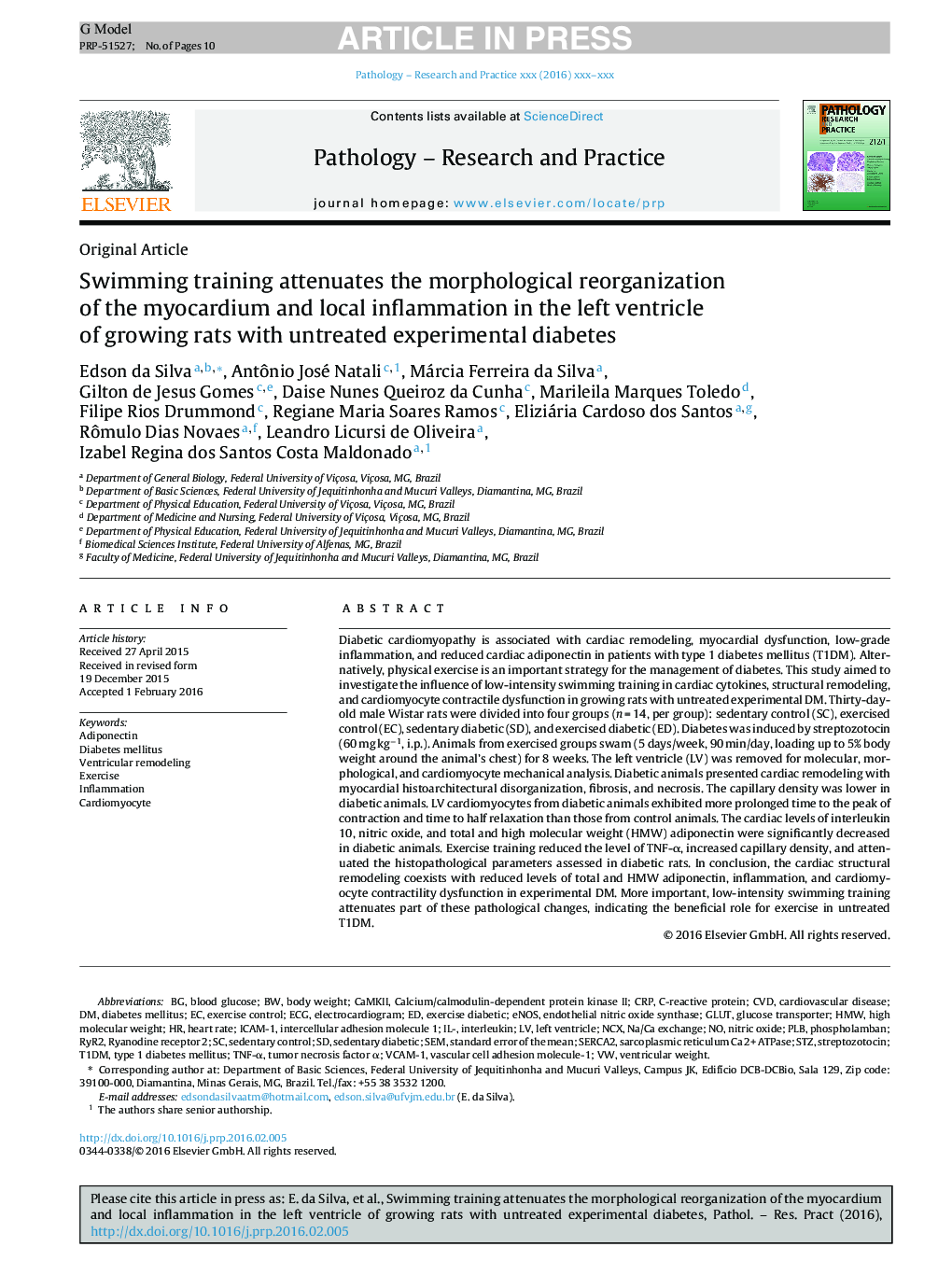| Article ID | Journal | Published Year | Pages | File Type |
|---|---|---|---|---|
| 10916806 | Pathology - Research and Practice | 2016 | 10 Pages |
Abstract
Diabetic cardiomyopathy is associated with cardiac remodeling, myocardial dysfunction, low-grade inflammation, and reduced cardiac adiponectin in patients with type 1 diabetes mellitus (T1DM). Alternatively, physical exercise is an important strategy for the management of diabetes. This study aimed to investigate the influence of low-intensity swimming training in cardiac cytokines, structural remodeling, and cardiomyocyte contractile dysfunction in growing rats with untreated experimental DM. Thirty-day-old male Wistar rats were divided into four groups (n = 14, per group): sedentary control (SC), exercised control (EC), sedentary diabetic (SD), and exercised diabetic (ED). Diabetes was induced by streptozotocin (60 mg kgâ1, i.p.). Animals from exercised groups swam (5 days/week, 90 min/day, loading up to 5% body weight around the animal's chest) for 8 weeks. The left ventricle (LV) was removed for molecular, morphological, and cardiomyocyte mechanical analysis. Diabetic animals presented cardiac remodeling with myocardial histoarchitectural disorganization, fibrosis, and necrosis. The capillary density was lower in diabetic animals. LV cardiomyocytes from diabetic animals exhibited more prolonged time to the peak of contraction and time to half relaxation than those from control animals. The cardiac levels of interleukin 10, nitric oxide, and total and high molecular weight (HMW) adiponectin were significantly decreased in diabetic animals. Exercise training reduced the level of TNF-α, increased capillary density, and attenuated the histopathological parameters assessed in diabetic rats. In conclusion, the cardiac structural remodeling coexists with reduced levels of total and HMW adiponectin, inflammation, and cardiomyocyte contractility dysfunction in experimental DM. More important, low-intensity swimming training attenuates part of these pathological changes, indicating the beneficial role for exercise in untreated T1DM.
Keywords
eNOSsedentary controlSerca2PLBIL-VCAM-1T1DMNCXGLUTexercise controlSTZCaMKIIHMWICAM-1RyR2adiponectinstreptozotocininflammationelectrocardiogramECGinterleukinVentricular remodelingleft ventriclecardiovascular diseasetumor necrosis factor αGlucose transporterstandard error of the meanDiabetes mellitustype 1 diabetes mellitusCVDendothelial nitric oxide synthaseHeart rateTNF-αphospholambanCardiomyocyteNa/Ca exchangeSEMIntercellular adhesion molecule 1vascular cell adhesion molecule-1Nitric oxideexercisebody weighthigh molecular weightC-reactive proteinCRPcalcium/calmodulin-dependent protein kinase IIBlood glucoseRyanodine receptor 2
Related Topics
Life Sciences
Biochemistry, Genetics and Molecular Biology
Cancer Research
Authors
Edson da Silva, Antônio José Natali, Márcia Ferreira da Silva, Gilton de Jesus Gomes, Daise Nunes Queiroz da Cunha, Marileila Marques Toledo, Filipe Rios Drummond, Regiane Maria Soares Ramos, Eliziária Cardoso dos Santos, Rômulo Dias Novaes,
